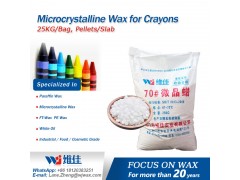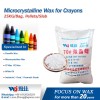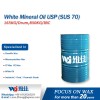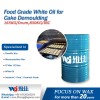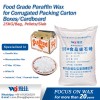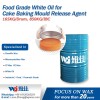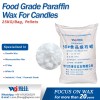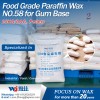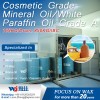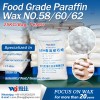Micro wax is derived from petroleum and undergoes a refining process to remove impurities. It consists of small, interconnected crystals that give it its unique properties. When used in crayons, it provides a smooth and creamy texture, allowing for easy application on paper.
The addition of microcrystalline wax to crayon formulations helps to improve their durability and break resistance. It enhances the adhesion of pigments to paper, resulting in vibrant and long-lasting colors. The wax also contributes to the crayons' ability to blend and layer smoothly, enabling children to create various shades and effects in their artwork.
Furthermore, micro wax offers some water resistance, protecting the crayon marks from smudging or running when exposed to moisture. It also helps to prevent the crayons from becoming too brittle or soft under different temperature conditions.
Overall, microcrystalline wax is a crucial component in the production of crayons, providing them with desirable qualities such as smooth application, durability, and vibrant colors. Its unique properties make it an excellent choice for creating high-quality crayons that children can enjoy using for their artistic endeavors.
Technical Data Sheet
Product Name: Microcrystalline Wax
Executive Standards: SH/T 0013-2008
|
DEscriptION |
METHOD |
SPECIFICATION |
|||||
|
MODEL |
70# |
75# |
80# |
85# |
90# |
||
|
dro Melting Point/℃ |
GB/T 8026 |
67-72 |
72-77 |
77-82 |
82-87 |
87-92 |
|
|
Penetration |
≤ |
GB/T 4985 |
30 |
30 |
20 |
18 |
14 |
|
Penetration |
GB/T 4985 |
Report |
|||||
|
Oil Content w/% |
≤ |
SH/T 0638 |
3.0 |
||||
|
Colour /NO. |
≤ |
GB/T 6540 |
3.0 |
||||
|
Kinematic Viscosity @100 ℃/(mm²/s) |
≥ |
GB/T 265 |
6.0 |
10 |
|||
|
Water Soluble Acid Or Alkali |
SH/T 0407 |
None |
|||||
1. Q: Besides crayons, what are some other common applications of microcrystalline wax?
A: Micro wax has a wide range of applications. It is commonly used in the manufacturing of candles, cosmetics (such as lipsticks and creams), pharmaceuticals (as a coating for pills), food (as a glazing agent for fruits and confectionery), and in various industrial processes like coatings, adhesives, and polishes.
2. Q: What are the advantages of using micro wax in cosmetic products?
A: It offers several advantages in cosmetic products. It provides a smooth and creamy texture, enhancing the application and spreadability of lipsticks, creams, and balms. It also helps to stabilize and emulsify formulations, improving the overall consistency and shelf life of the products. Additionally, microcrystalline wax provides a protective barrier on the skin, preventing moisture loss and keeping the skin hydrated.
3. Q: How is micro wax used in the preservation of artworks?
A: It is commonly used in art conservation and restoration to protect and preserve artworks. It can be applied as a protective coating on paintings and sculptures to safeguard them from dust, pollutants, and environmental damage. The wax creates a barrier that prevents moisture and humidity from reaching the artwork, reducing the risk of deterioration. Its low refractive index also ensures that the wax layer does not interfere with the visual appearance of the artwork.


